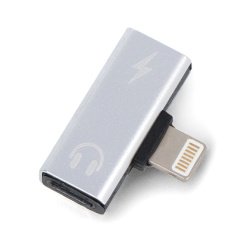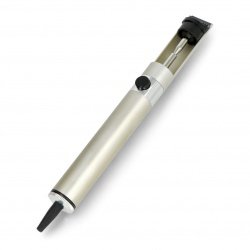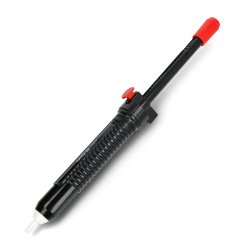Braided solder – or how physics helps electronics
Tin suction braid allows for easy and precise removal of excess or all tin from both through-hole (THT) and SMD connections. Products of this type simply apply to the soldering area.
The principle of its operation is very simple - the tin heated with the soldering tip is automatically "pulled" between the thin wires of the braid, and this is caused by the forces of molecular interactions on the microscale.
Tin sucker - what else is worth knowing about it?
Since the braid is made of copper, to which tin adheres very easily, there is no need to use any additional tools - just touch the end of the clean braid to the heated solder, and it will soak into the structure without your help, removing the solder from the solder pad of the printed circuit board. The width of the braid should be selected according to the size of the connection, so it is always worth having several different wires at hand, e.g. 1 mm, 2.5 mm and 3 mm, which facilitate soldering.
Solder extractors and their use in service and assembly
The principle of operation of tin extractors is more obvious than that of braided ones - an ordinary vacuum is used, generated by a small piston that moves out rapidly when the lock is released. The syny aspirator is equipped with a piston that moves in the cylinder under the action of a spring, causing tin to be sucked into the cylinder.
The main difference between working with an aspirator and a braid results from the effectiveness of both methods - removing tin using a braid is very precise, but it only works well with smaller amounts of tin (after a while you have to use another piece of wire, cutting off the previously used one, i.e. soaked). solder).
In turn, a tin extractor is a product that allows you to quickly remove larger amounts of tin, therefore it is much better suited for working with connections of THT elements - through-hole resistors, large capacitors, coils, connectors, transistors and integrated circuits. The soldering extractor is easy and intuitive to use. This type of product is chosen by both experienced and beginner electronics enthusiasts. We encourage you to read the entire soldering section, where you can find, among others: tin and soldering pastes , tips , holders and magnifiers for electronics and much more.
Other soldering equipment
In addition to planning the purchase of braids and aspirators, it is also worth thinking about your own health - as we know, when soldering, flux fumes and smoke are emitted from the tip, which not only can irritate the eyes and respiratory tract, but also adversely affect health during longer assembly and service work. . Therefore, it is really worth equipping your studio with a fume absorber, which, in addition to a large fan, also includes an activated carbon filter that cleans the air sucked in by the fan and prevents harmful fumes from accumulating in the room.
Our offer includes both stationary absorbers (AKS-153) and those placed on booms (AKS-153A), which greatly facilitates work in the case of small worktable dimensions. In the Botland online store you will find a wide selection of products coming directly from manufacturers or proven suppliers.
Aspirators and braids - FAQ





































































































































































































































































































































































